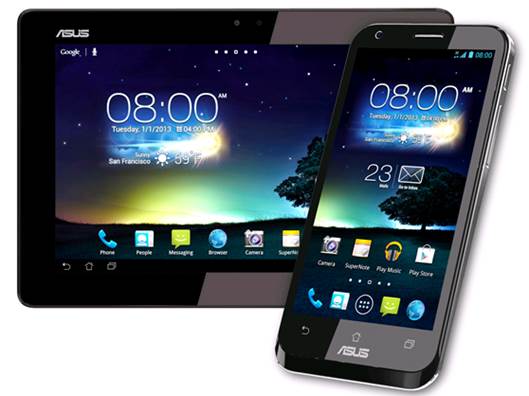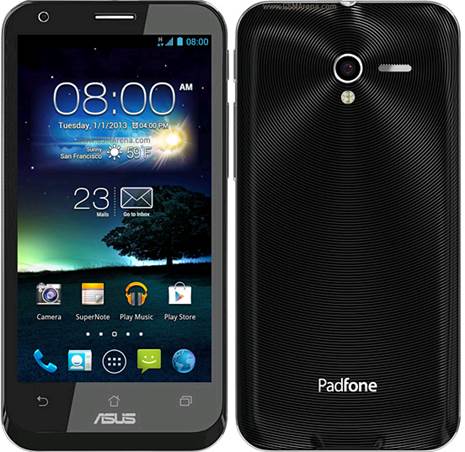The Padfone 2 is a superb marriage of
tablet and smartphone, though the tablet is definitely the poor cousin
Price: $899
Website: www.asus.com
If you’ve got some spare cash burning a
hole in your pocket and you can’t decide whether you want a new phone or a
tablet, the Asus Padfone 2 might come to your rescue. It’s both. The phone is a
fully fledged handset, self-contained and able to work on its own - in all the
ways you expect a high-end Android handset to.

Asus
Padfone 2
But when you fancy a 10.1-inch tablet
instead, you have one of those as well. The phone slots into the back of a
tablet shell and gives its big screen and battery a heart. The combination
price of $899 is high enough to initially take some of the gloss off what is
undoubtedly an innovative product - you might have been hoping more for a
two-for-the-price-of-one deal - and it might be more than you’d ever have
expected to spend on a phone. But if you are in the market for both a phone and
a tablet, the price combination is quite attractive. Asus has married the two
elements in such a way that the combination offers a couple of distinct
advantages too - most notably when it comes to power management.
One thing to be aware of right from the
start is that the tablet doesn’t do anything on its own. It has no internals,
as such, and it needs the phone to be slotted in before it will even switch on.
The tablet then uses the phone’s 13-megapixel camera (hampered down to 5.5
megapixels) and headset slot, the phone’s Bluetooth, GPS, Wi-Fi and 4G
connections, and, of course, its processor and memory. The small phone screen,
too, transforms into a large tablet one.

One
thing to be aware of right from the start is that the tablet doesn’t do
anything on its own. It has no internals, as such, and it needs the phone to be
slotted in before it will even switch on.
The layout of apps and widgets on phone and
tablet are managed separately so you can personalize things as if they were two
separate devices, but when you download apps and other data you do so to the
handset as the tablet has no storage of its own. Some apps can be set to
automatically switch between devices when you dock and undock so it is always
optimized for the screen size you are using.
That’s not the bed of roses you might
think, because memory is limited. There’s no memory expansion on either the
phone or the tablet, and the 32GB on the handset is down to just over 25GB of
actual free space out of the box. This is one of the downsides to the
two-in-one approach, since the likelihood is you’ll use a phone and tablet in
different ways - the phone for music; the tablet for movies, for example - and
you may need to compromise between them.
In design terms Asus has done its usual
slick job. The tablet is a bit of a block, but it has a nicely rubbery back and
gently curved edges. The handset has the optical illusion of being tapered
thanks to a metal strip along the long edges that is thinner at the bottom than
the top. The phone feels solid in the hand and its build quality is good.
The docking mechanism is secure and easy to
operate - you just push the handset into the slot till it will go no further,
and it slides out easily too.
The switch from phone to tablet mode
happens automatically, and almost seamlessly. The phone’s specs are very good,
matching leading devices like the Nexus 4. It is powered by a 1.5GHz quad-core
processor with 2GB of RAM in support, and it zips along. Its 4.7-inch screen, with
1,280 x 720 pixels looks great. The phone runs Android 4.1. It isn’t Vanilla
Android, but the skin is light and subtle and the tweaks feel necessary rather
than bloat.
The tablet is slightly less impressive. The
1,280 x 800 pixels on offer are barely any more than you get with the phone,
but stretched across an extra five inches of screen. The drop in relative
resolution is noticeable, taking the device from high-end phone to mid-range
tablet. To help things somewhat Asus has implemented a special ‘outdoor’
brightness mode that racks up the brightness, but this pushes the battery hard.
You can still take calls when the phone is docked - via speakerphone or a
Bluetooth headset.

The
1,280 x 800 pixels on offer are barely any more than you get with the phone,
but stretched across an extra five inches of screen.
As well as providing the larger screen the
tablet houses its own battery, and its use has been implemented very
intelligently. You can set things up so that the tablet battery is used first
so you have a well charged phone when you undock, and can use the tablet
battery to charge the phone. This really comes in handy if you find phone power
running short during the day as there’s no need to hunt around for the mains
adapter. Because both devices have micro USB slots you can charge them both
individually.
For some reason our review unit didn’t come
with the slightly modified micro USB cables that Asus wants you to use, and our
normal charge cables kept slipping out.
That said, the relatively low screen
resolution of the tablet, and the lack of micro SD storage on both devices
could be ongoing issues, but in general we can’t help thinking that the Padfone
2 is a fantastic piece of kit.
It’s a great idea, and Asus is one of
relatively few companies with the design and build chops to pull it off. It’s
not an option if you ever think you might want to use the tablet and phone at
the same time, but there’s undoubtedly lots to like.
Dumb tablet
The 10.1-inch tablet doesn’t have a life of
its own. The phone needs to be docked before you can use it
Smart battery
Neither phone nor tablet have any memory.
The phone and tablet both have batteries that can combine to give great life.
It’ll also work so that your phone is almost always well charged
USB
Micro USB provides charging in both tablet
and phone, but Asus uses a modified cable and standard ones tend to come adrift
readily
No memory expansion
Neither phone nor tablet have any memory
expansion capability so you may need to pick whether you want to prioritize
your phone content or tablet content
Great phone
Half of the Padfone 2 is a very decent
smartphone rivaling some of the biggest names on the market, especially with a
quad-core processor and 2GB of RAM

Half
of the Padfone 2 is a very decent smartphone rivaling some of the biggest names
on the market
Battery life
Battery life is generally excellent and you
can charge the phone from the tablet
Good for
Work
Working with documents is unsurprisingly a
treat on the tablet
Gaming
The big screen is good for gaming, but the
tablet’s pixel density could be better
Long life
There’s plenty of battery power here to
last you through extended periods
Time saving
Install apps once for both tablet and phone
for the perfect marriage
Verdict
·
Ratings: 4/5
·
A fantastic idea well implemented, though the
tablet does feel like an add-on rather than an equal
Performance
·
Ratings: 4/5
·
A fast and capable phone coupled with a fast but
less impressive tablet
Design
·
Ratings: 4/5
·
Clever docking mechanism and some stylish
hardware
Features
·
Ratings: 5/5
·
A truly innovative two products in one, with
high-end specs to match
Value for money
·
Ratings: 4/5
·
Not cheap, but cheaper than separate units in
almost all cases
|
Technical
specs
·
Operating system: Android 4.1
·
Processor: Quad-core 1.5GHz Qualcomm
Snapdragon S4
·
Memory: 32GB storage
·
Dimensions: phone: 137.9 x 68.9 x 9mm, tablet:
263 x 180.8 x 10.4mm
·
Weight: Phone: 135g, tablet: 514g
·
Display size: Phone: 4.7-inch, tablet:
10.1-inch
·
Display resolution: Phone 1,280 x 720 pixels,
tablet: 1,280 x 800 pixels
|